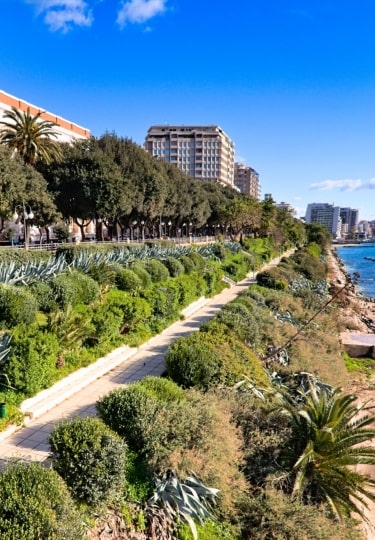Taranto, Italy, is like a kind of Italian San Diego. This southern city, situated on its eponymous gulf, is a wellspring of national history as well as a gleaming Italian port city with a major naval presence—and superb beaches.
It’s the second-largest city in the rustic province of Apulia—one of the most popular vacation destinations in Italy’s laidback south. The shallows of Taranto’s sandy, pebbly shores are as golden as the sought-after Apulian olive oil soaked up by your chunk of durum wheat bread in this sunny breadbasket of Italy’s lower latitudes.
Why Visit Taranto
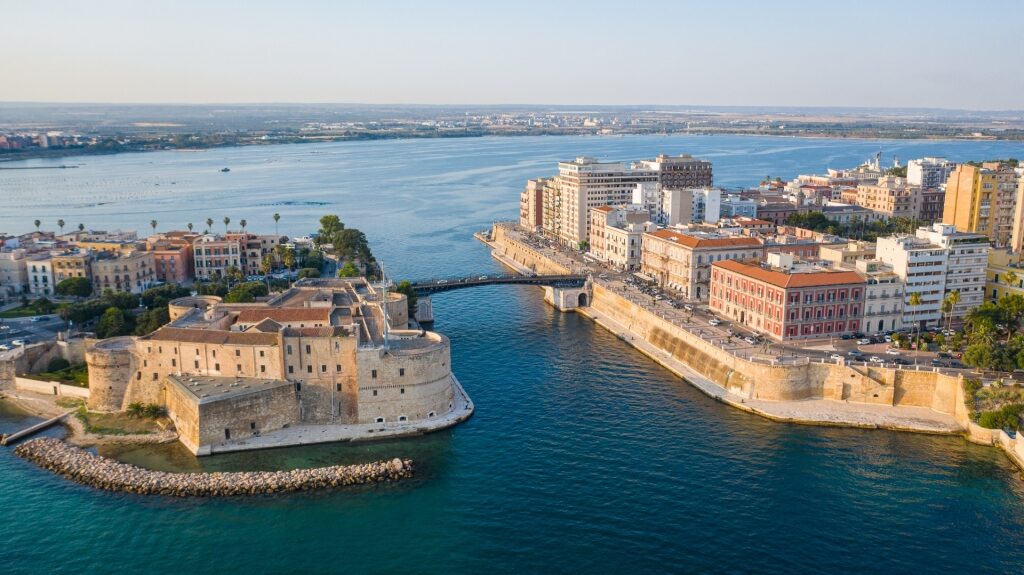
Taranto
History, archaeology, food, beaches—there are many reasons you’ll love Taranto.
The city’s modern facelift belies its ancient origins; the city has a history that stretches back to the time of the ancient Greeks.
You’ll find much evidence of its Spartan founders clustered among the elegant decay of its baroque Borgo Antico, a maze of narrow lanes enveloped in the smell of garlic wafting from the kitchens and the cries of the gulls mobbing the fishing boats.
This historic center is enclosed upon its own island (the Isola Della Citta Vecchia) connected to its modern self by the 19th-century Ponte Girevole swing bridge.
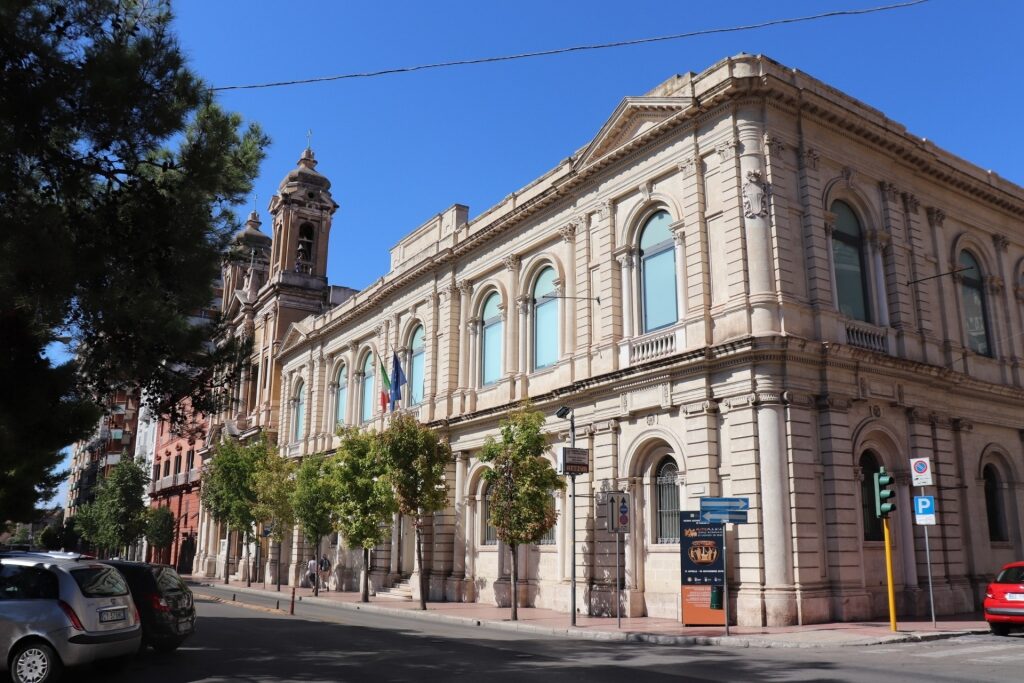
National Archaeological Museum of Taranto Photo by Fabien Bièvre-Perrin on Wikimedia Commons, licensed under CC BY-SA 4.0
However, the city’s greatest collection of ancient artifacts (and one of the south’s most important museums) is found in the National Archaeological Museum of Taranto located in the newer part of town.
But beyond being one of the most beautiful cities in Italy, it’s also centrally located for day trips to local showstoppers such as Ostuni, Alberobello, and silver screen darling, Matera.
History & Culture
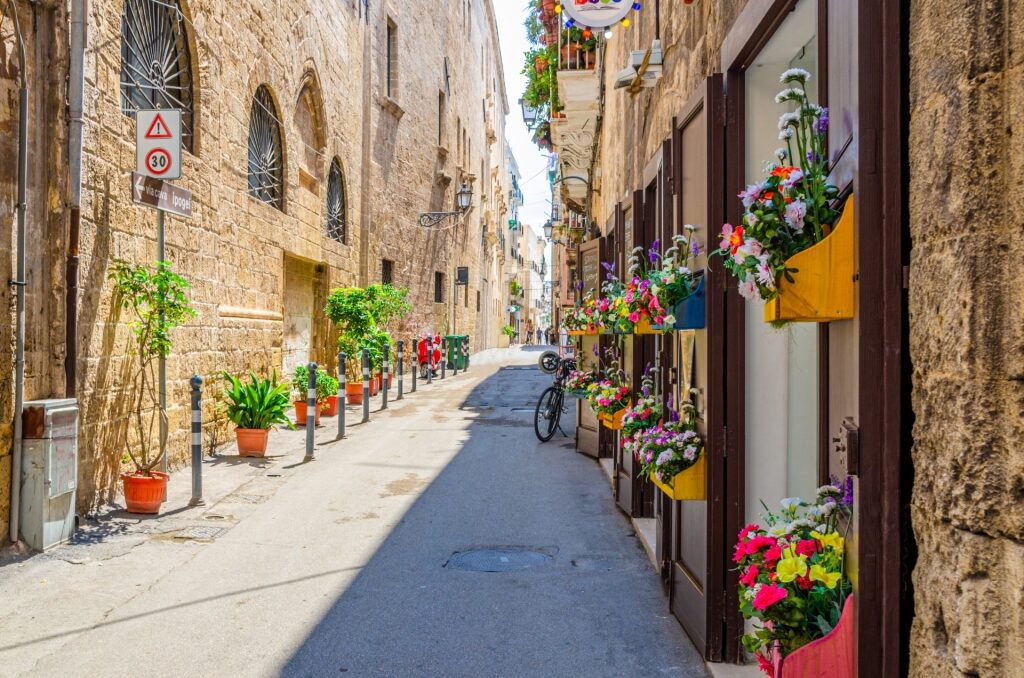
Taranto
Taranto, Italy, was the product of the Grecian Golden Age of the 8th century BC. Its seed village was called “Taras” (named for the son of the sea god, Poseidon) and was founded by Spartan colonizers.
With its sheltered harbor and fertile plains, Taras quickly established itself as one of the ancient world’s largest population centers by 500 BC.
One of the pre-eminent colonies of Magna Graecia, Taras reached its peak around the 4th century BC under the stewardship of notable statesman-philosopher, Archytas. Its rise was eventually checked by the expansion of the Romans as they pushed south along the peninsula.
Once the Romans had conquered Taras (renaming it “Tarentum”), they proceeded to diminish its significance as a commercial port. With the Via Appia connecting it directly with Rome, Bari became the anointed port-city of the south, while bypassed Taranto lost ground to its Adriatic coast competitor.
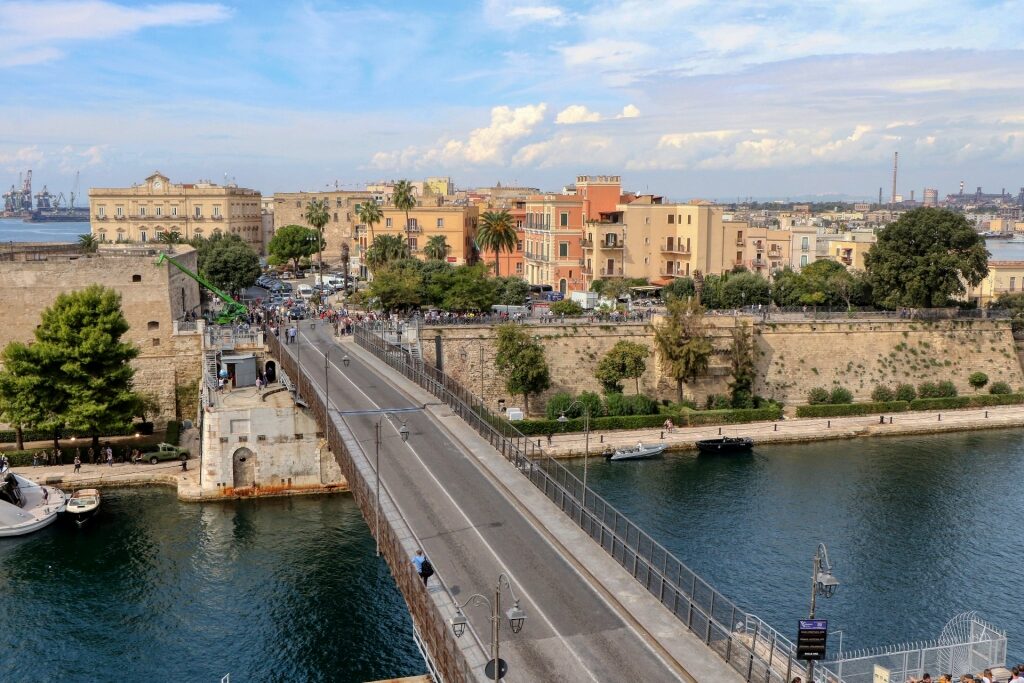
Ponte Girevole
After the Romans, Taranto’s tumultuous history continued as control of the strategic port bounced for nearly a millennium between the Byzantines, the Saracens, the Normans, the Spanish, and the French until eventually becoming part of Italy in 1861.
After becoming Italy’s main naval base during the two World Wars, Taranto went on to become a major center for industry and steel production.
Tips for Visiting Taranto
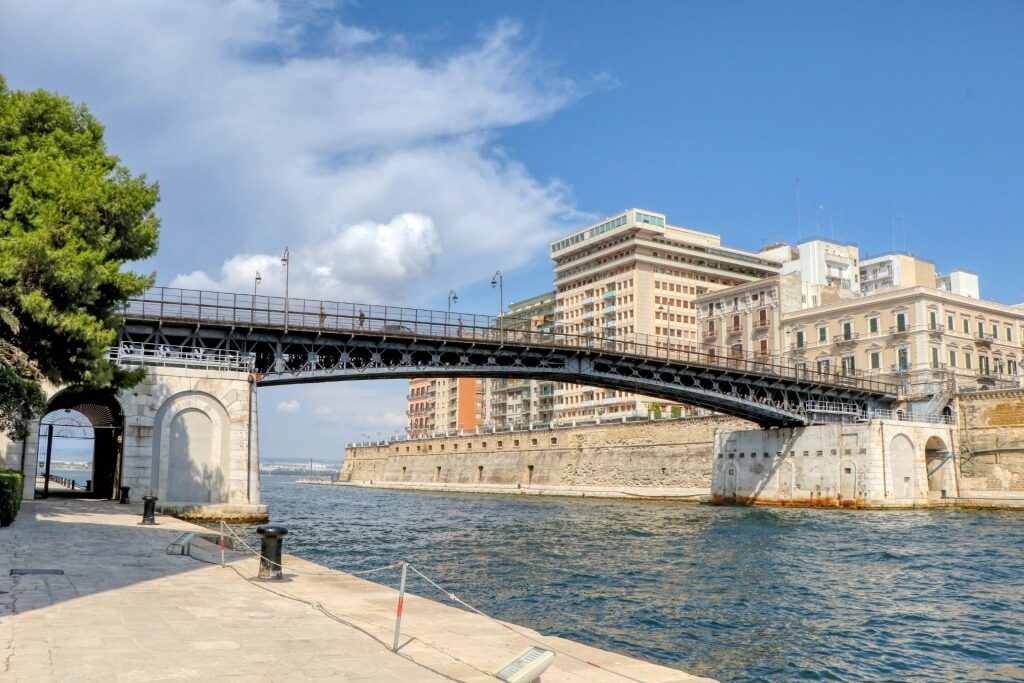
Borgo Antico
An oft-trotted-out cliché is that cities are a mix of the “old and the new”. No such fear with Taranto, Italy. Its city is definitively split between the Borgo Antico and the modern development found across the two bridges connecting the artificial island with the mainland.
For most visitors, it’s the Borgo Antico floating between “Big Sea Bay” and the inland lagoon known as the Mar Piccolo, or “Little Sea” that holds the most interest.
On this ancient isle, you’ll enjoy the views out into both bodies of water, pass couples elbow deep in pots of glistening mussels at seafront tables, and wander in the footsteps of the early Spartans past astonishing historical sights such as The Poseidon Temple.
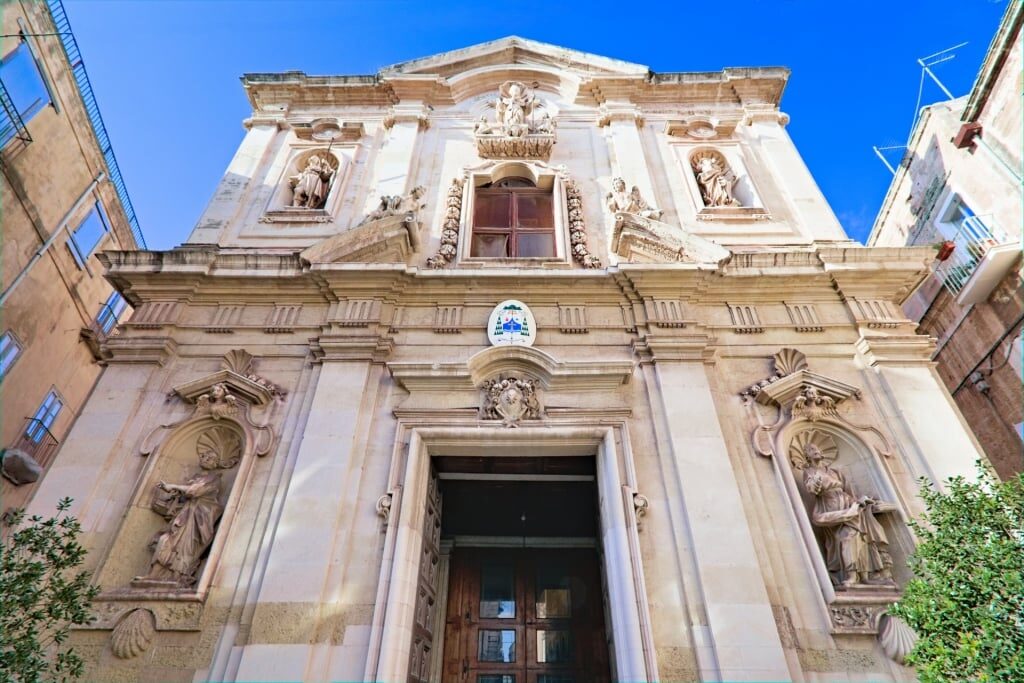
Taranto Cathedral
However, a wonderful first stop for getting to know la Città Dei Due Mari (“the City of the Two Seas” as Taranto is also known) is Taranto Cathedral. Something of a symbol of the city’s identity, its handsome—if unarresting—18th-century facade gives way to a medley of unexpected treasures within.
In this 11th-century building with a Byzantine-style cupola, you’ll find remnants of 800-year-old mosaics on the floor depicting Bible stories and mythical creatures. Along with the impressive frescoes by the Renaissance artist Paolo de Matteis, you’ll be entranced by the marble inlays of the Chapel of San Cataldo.
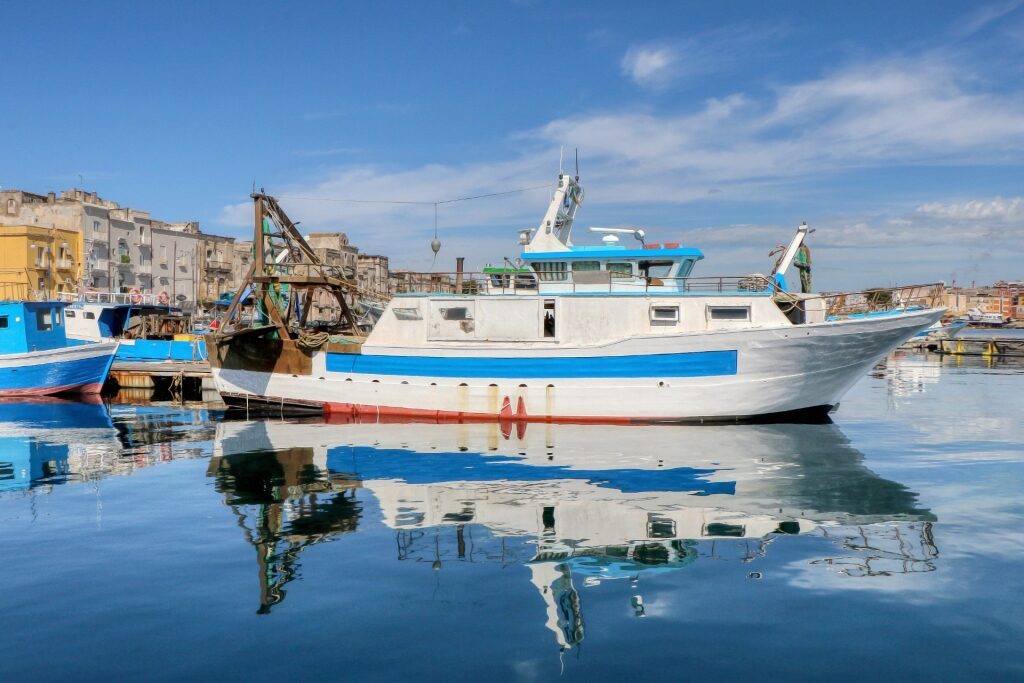
Taranto
Afterward, wander out from the cathedral and find your way to the north side of the island. Here, facing in towards the Mar Piccolo is the island’s marina filled with bobbing fishing boats.
Arrive early to the northeast corner to find the fish market with all its brawny gusto, trays of spiny urchins for sale, and timeless pungency of the sea.
To see some of the gulf’s inhabitants in better health, find the offices of the Jonian Dolphin Conservation on the Borgo Antico. Book a tour with them to see dolphins thriving in the Ionian Sea—a perfect combination of boat ride and marine education.

Taralli biscuits
Alternatively make your way to one of the city’s golden sand beaches for a different, more low-key form of marine education. Afterward, relax with a glass of chilled Apulian rosé on hand and a bowl of more-ish fennel-seed taralli biscuits at a beachfront restaurant.
Things to Do & Attractions in Taranto
Stroll the Lungomare Vittorio Emanuele
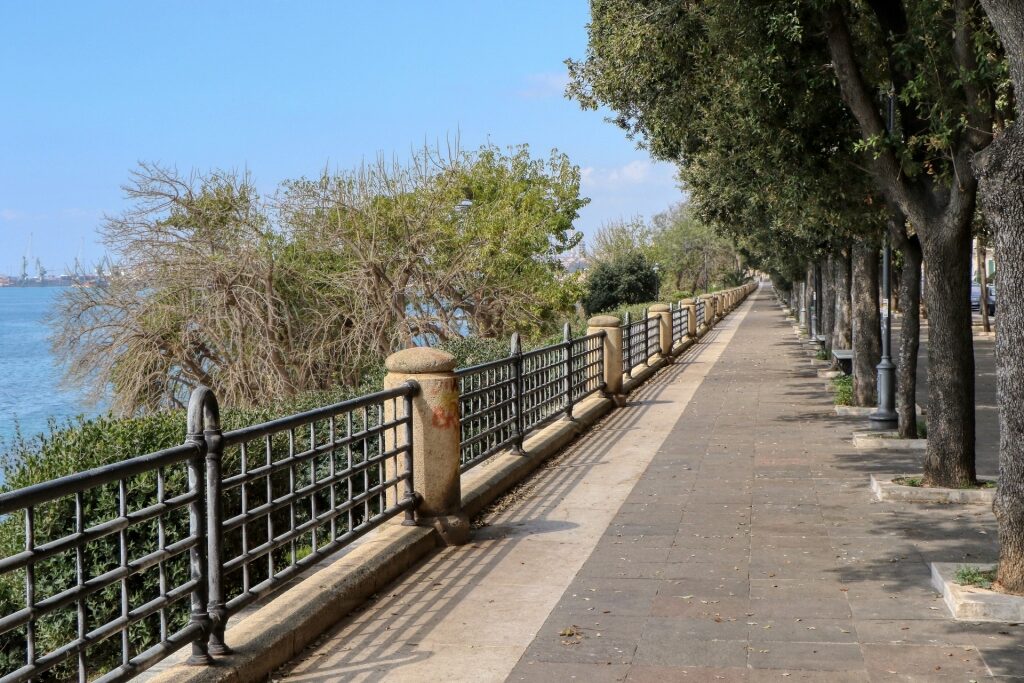
Lungomare Vittorio Emanuele
On the southern edge of the new city with views out into the Mar Grande and towards the rugged brown mountains of distant Calabria, the Lungomare Vittorio Emanuele is a tree-shaded boardwalk with cafés, gelaterias, and occasional benches for sitting and contemplating the sailboats, your gelato (or, indeed, both).
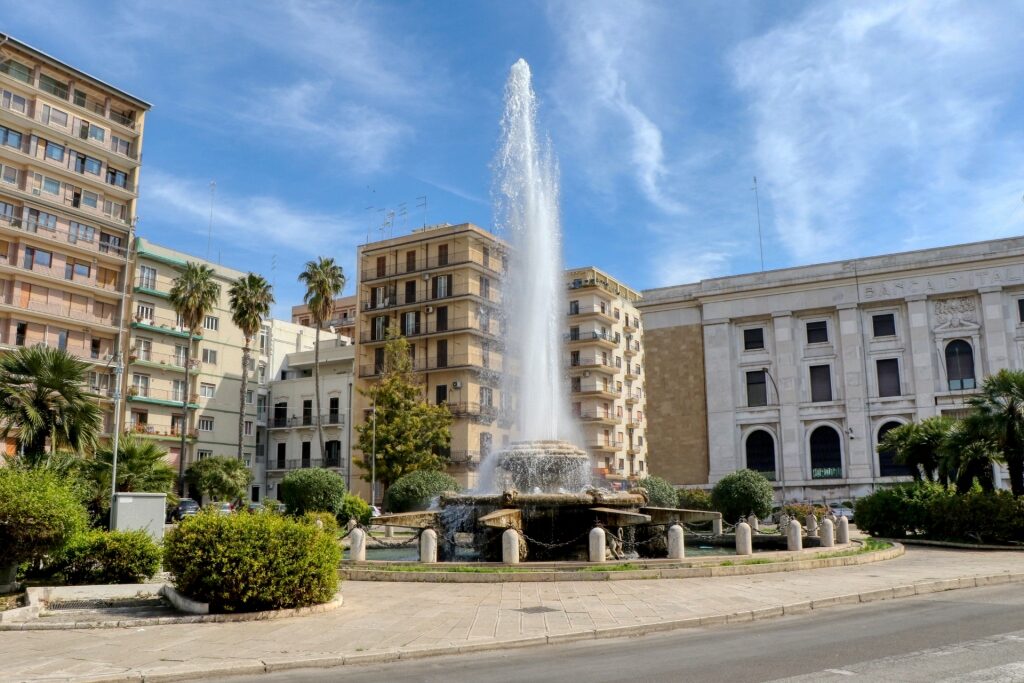
Piazza Ebalia
Near its southern end is Piazza Ebalia with its impressive fountain (lit up in patriotic tricolor at night). As you approach the northern extent of this polished stone promenade you’ll see your next destination across the bridge: the robust curves of the Aragonese Castle, one of the most beautiful castles in Italy.
Take a moment before crossing to admire the bronze Monument to the Sailor—dedicated to the Italian navy. Then take another moment to acquire a large scoop of gelato at Gelateria Del Ponte near the bridge.
Explore the Castello Aragonese
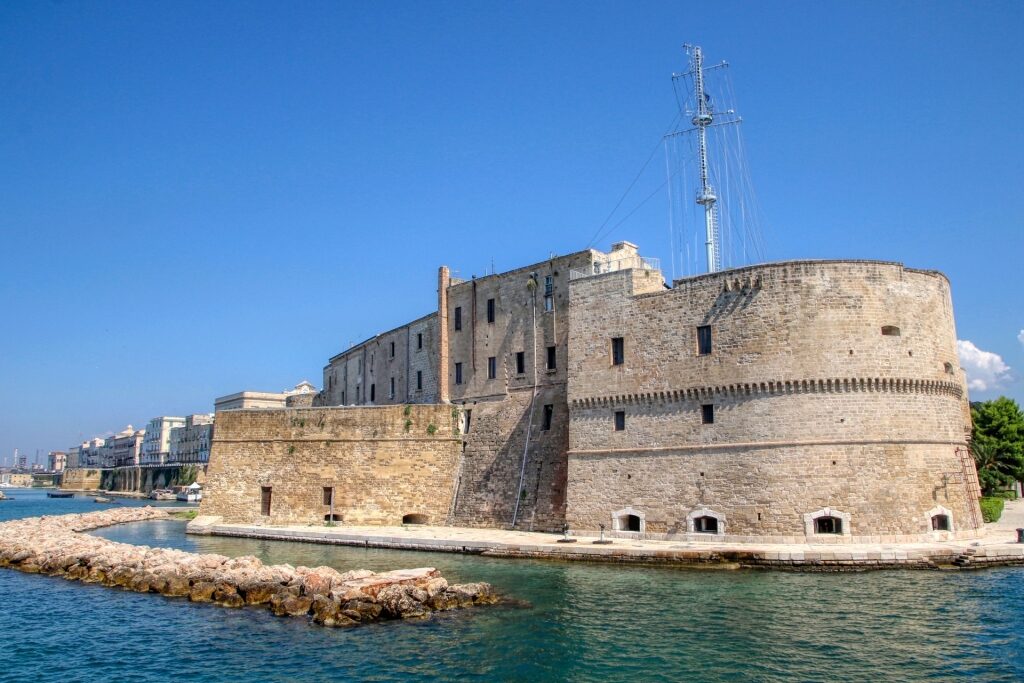
Castello Aragonese
Cross over the Ponte Girevole—looking hopefully into the clear water for a glimpse of a turtle or dolphins passing beneath—and make your way to the famous Aragonese Castle (or “Castello Aragonese”).
This seafront bulwark was built between 1486 and 1492 by King Ferdinand II of Aragon as protection from Turkish raiders. Built upon a 9th-century Byzantine fortress, these foundations indicate that raids have long been a problem on this slice of gorgeous Apulian coastline.
By the 18th century, the castle had become a prison for the Habsburgs’ enemies. Today it’s an absorbing museum and atmospheric concert venue. Restored by the Italian navy, the guided tours of its cannons, remnants of Byzantine detail, and exhibits about Tarantese history are led by acting naval officers.
Discover the City’s Origins
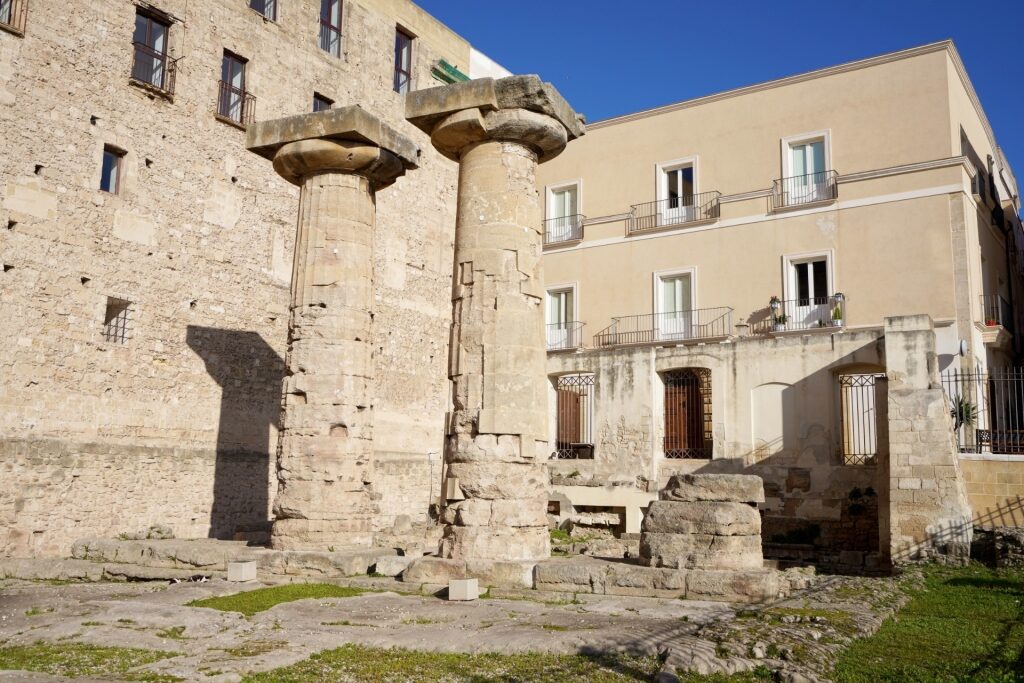
Temple of Poseidon
Once you leave the castle, head around the corner to the Temple of Poseidon. Don’t expect the Parthenon—all that remains on this profoundly ancient site is a grassy patch of paving and two stoic Doric columns.
Dating back to the 6th century BC (so built before the Parthenon), this is, in fact, the oldest temple in Magna Graecia.
To dig deeper into Taranto’s early origins, visit the nearby Spartan Museum. On the Mar Grande-facing waterfront, just north from the Temple of Poseidon, you’ll descend into a series of underground chambers.
Within this private museum/passion project are artifacts and replicas from Taranto’s Spartan origins, as well as the city’s best-preserved hypogeum.
Take in Archaeological Treasures
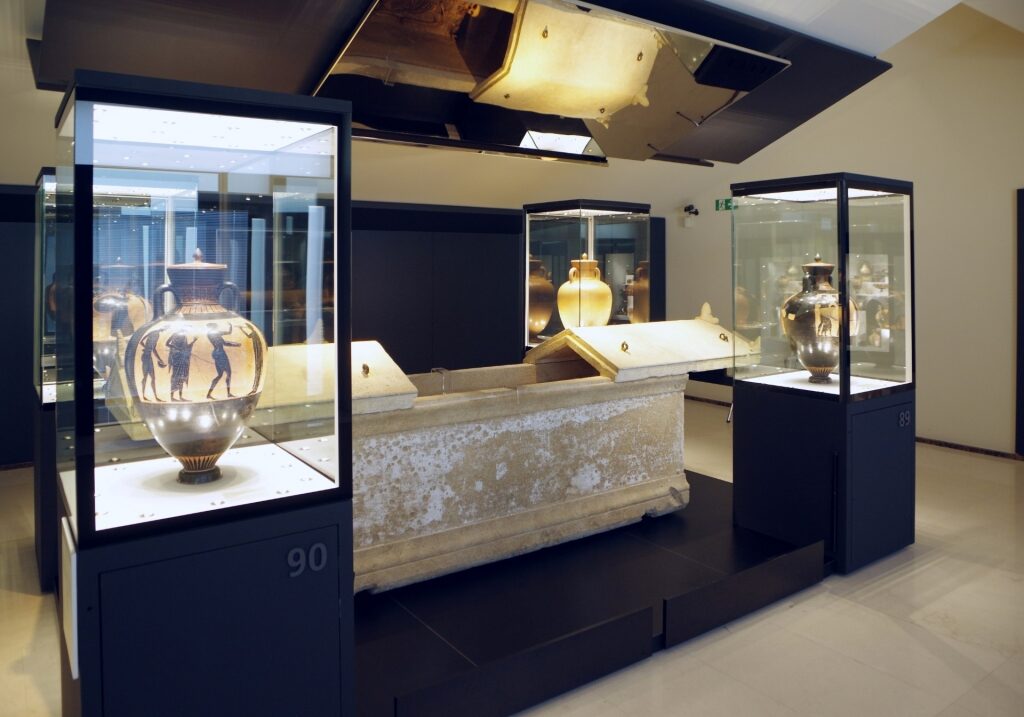
Museo Nazionale Archeologico di Taranto Photo by Berthold Werner on Wikimedia Commons, licensed under CC BY-SA 3.0
With museum appetite whetted, cross back over the bridge into Taranto’s modern quarter and find your way to the Museo Nazionale Archeologico di Taranto (or MArTA to her friends). Taranto’s world-class museum is dedicated to the city’s ancient history as well as Magna Graecia as a whole.
MArTA, located in the elegant surrounds of a former monastery beside the Giardini Garibaldi piazza, is full of archaeological gems and mind-blowing examples of early Greco-Italian art. Opened in 1887, it’s been recently restored and brought fully up to date, offering an in-depth narrative about Taranto’s early cultural evolution.
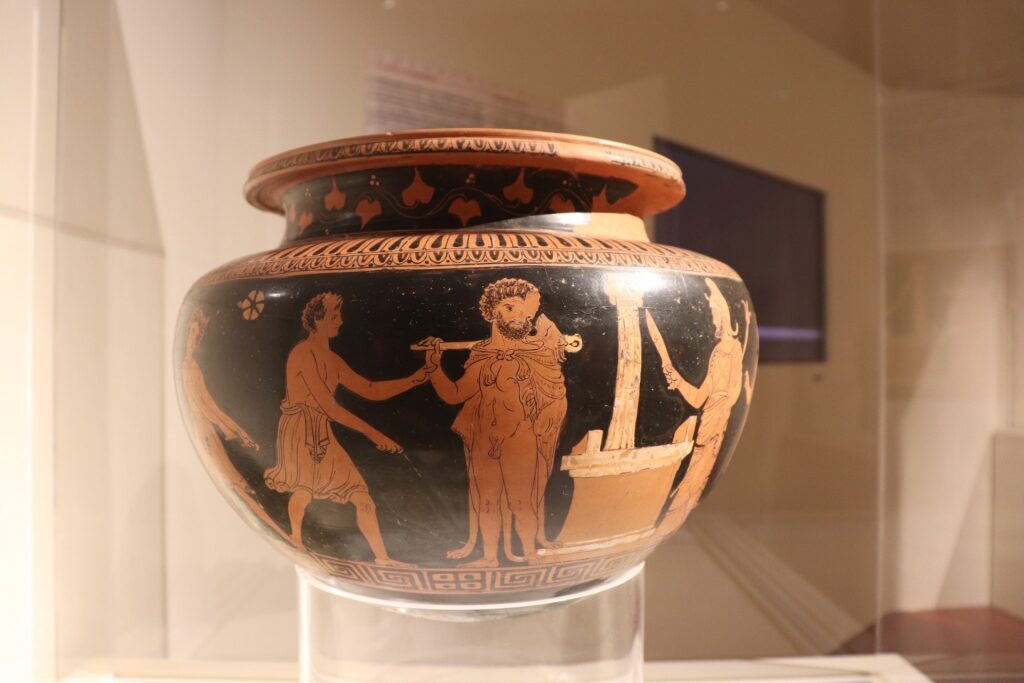
Museo Nazionale Archeologico di Taranto Photo by Fabien Bièvre-Perrin on Flickr, licensed under CC BY-SA 2.0
Over two floors of modern, well-lit displays you’ll browse the world’s largest collection of Grecian terracotta figurines, an odyssey of Attic vases—with their distinctive black-on-red silhouette decoration—and items retrieved from tombs including the Oro di Taranto jewelry and a crown from the 4th century BC. Another exhibit records multi-faith harmony in Taras.
Marvel at Matera
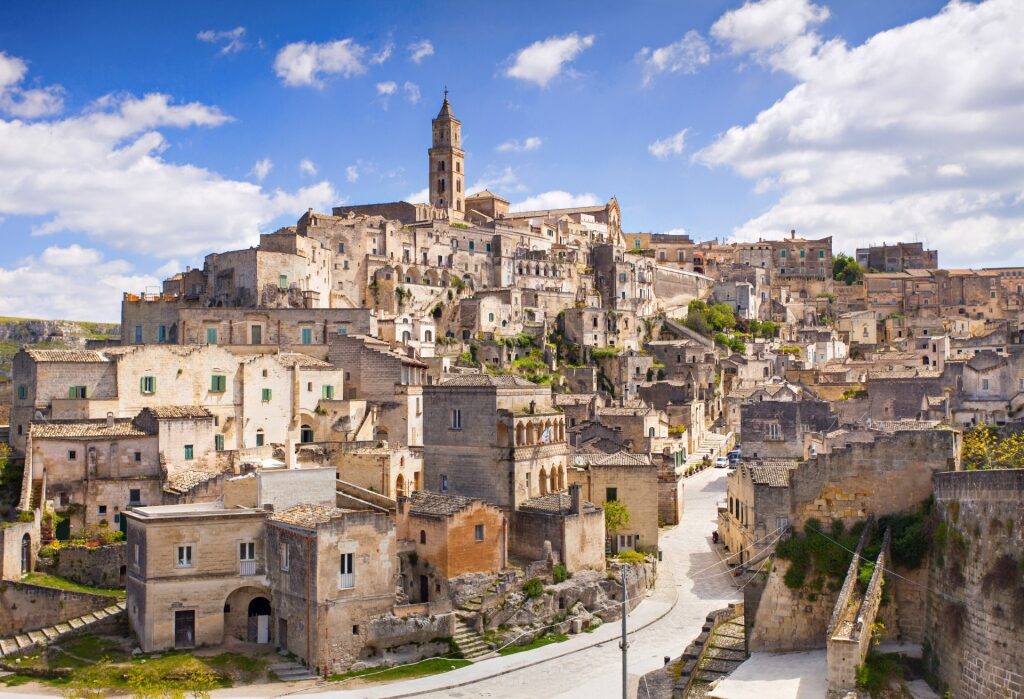
Matera
If, after MArTA, you feel like you can almost see the ancient world around you, why not go one better and actually touch it with a day trip to Matera?
This stunning city, located in the neighboring province of Basilicata, ranges across two sides of a dramatic river canyon. Besides its show-stopping situation, Matera is also famous for its Sassi cave dwellings.
These remarkable habitations are caves dug into the gorge’s calcareous rock face. They’ve been used as homes since prehistoric times, and while they were an area of great deprivation in the 20th century, today they’ve been cleaned up and converted into an engaging UNESCO site (as well as some truly one-off B&Bs).
Lose Yourself in Ostuni
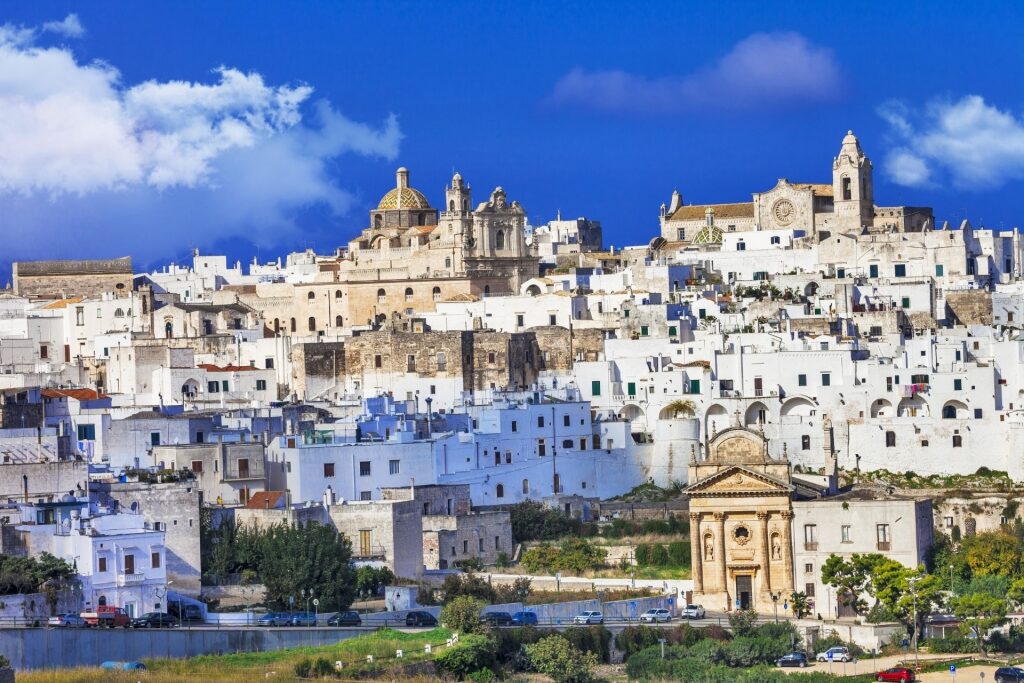
Ostuni
A different vibe awaits in Ostuni—another worthy day trip about an hour from Taranto, Italy. When seen across the azure waves of the Adriatic, the blocky architecture of white-washed Ostuni looks like a pile of giant sugar cubes. This distinctive appearance gives this popular seaside destination its nickname of “the White Town”.
There’s a very nice medieval cathedral here—as you’d expect of any Italian destination worth its salt—but the main joy of a visit to Ostuni is becoming (often quite literally) lost in its winding, flower-brightened lanes.
Alight at an alleyway café for directions, a reviving shot of sunny limoncello, and a chat. If you’d like to cool off, the Adriatic is a five-minute drive.
Lounge at the Lido
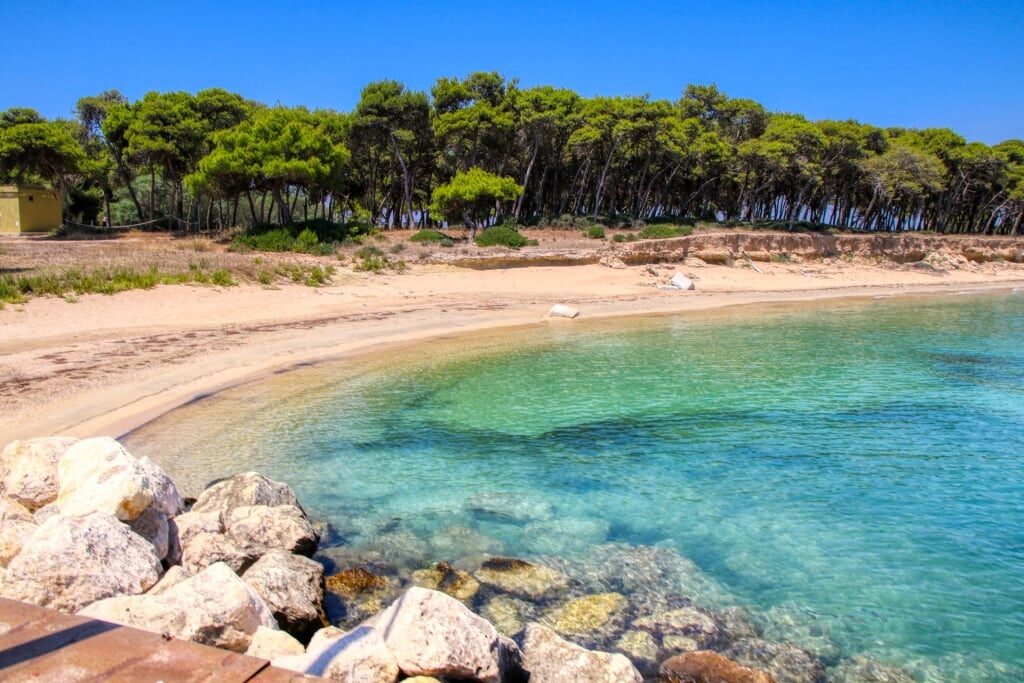
Isola di San Pietro
Of course, having been enticed by the views of some of the best beaches in Italy while strolling Taranto’s Lungomare Vittorio Emanuele, you may prefer to dig your toes into Tarantine sand.
Lido Taranto, found at the southern end of the promenade, is the best option near to town (unless you’re hopping on a ferry to Spiaggia Lo Scanno on Isola di San Pietro).
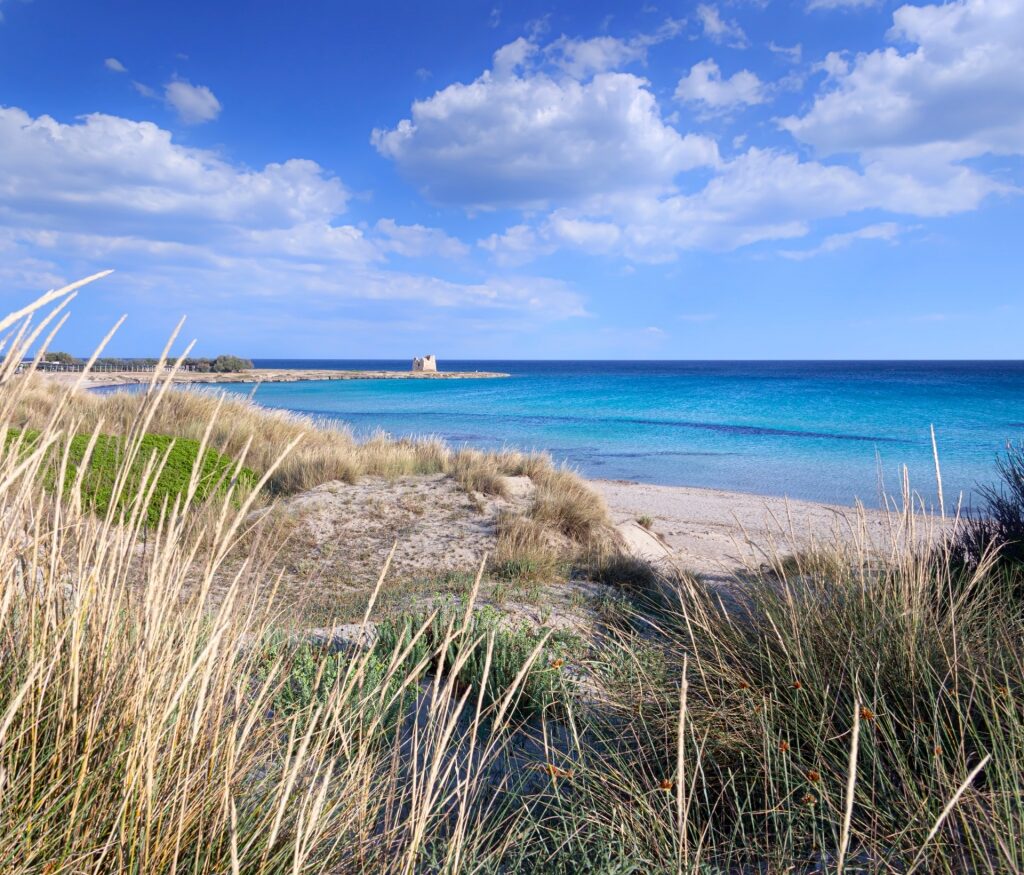
Spiaggia Della Torretta
If you’ve time, a half-hour drive south will throw up all sorts of exquisite beachy possibilities. The best is probably Spiaggia Della Torretta, with its ruined watchtower, frequently likened to the Caribbean for its water clarity and sand sugariness.
Food & Drink
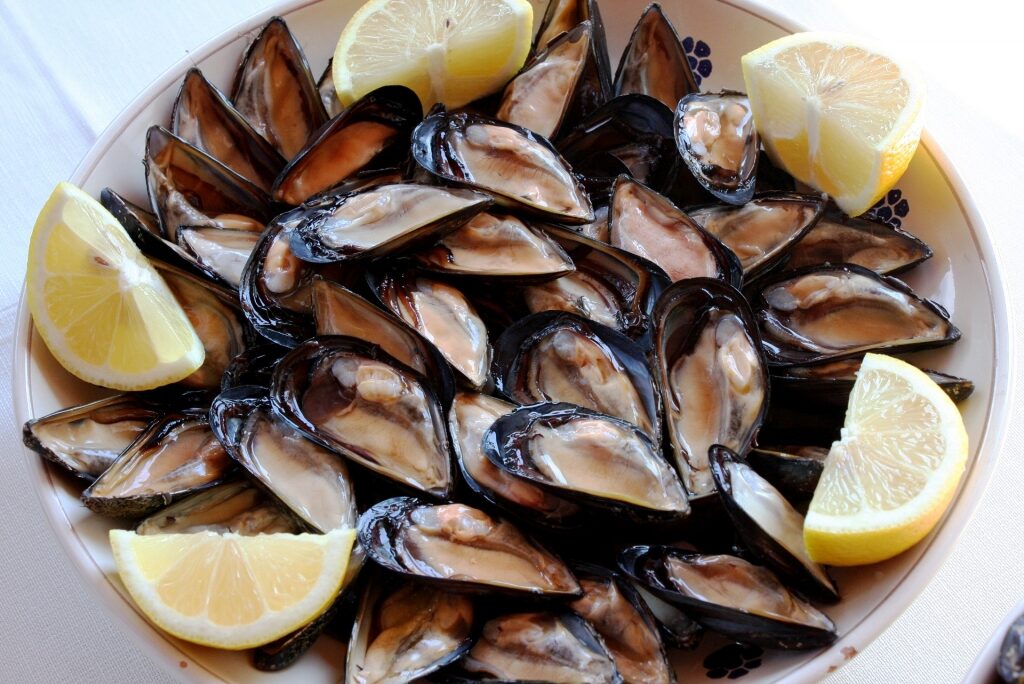
Mussels
If you love “cozze” (mussels), then Taranto, Italy, is your mothership. Thanks to the unusual geographical arrangement of the city’s freshwater Little Sea and its saltwater Big Sea, the perfect conditions exist in this area for the cultivation of flavorful mussels.
Old school La Paranza, located in the Citta Vecchia near the lagoon’s mussel farms, is the place to dig in.
Renowned throughout the peninsula for its delicious rosy flesh, the Taranto mussel is the star of the city’s menus. Expect mussels tangled in pasta, mixed in among a parsley-sharpened risotto, or just splashed with lemon juice and eaten raw.
If you prefer oysters, look for them roasted and tangy tossed in oil, lemon, garlic, and marjoram.

Orecchiette pasta
It’s not all seafood, however. Lamb is everywhere in Apulia, often cooked over a spit with rosemary in a nod to the Greek influence in this area. Also on the menu of most family-owned trattorias in Apulia are bowlfuls of orecchiette pasta drizzled with the region’s famously flavorful extra virgin olive oil.

Burrata
This province in southern Italy is also the land of burrata—the cream-filled apotheosis of mozzarella—so be sure to order some of this snow-white decadence with your antipasti. Feel healthier by loading your pockets with Taranto’s sweet, aromatic clementines.
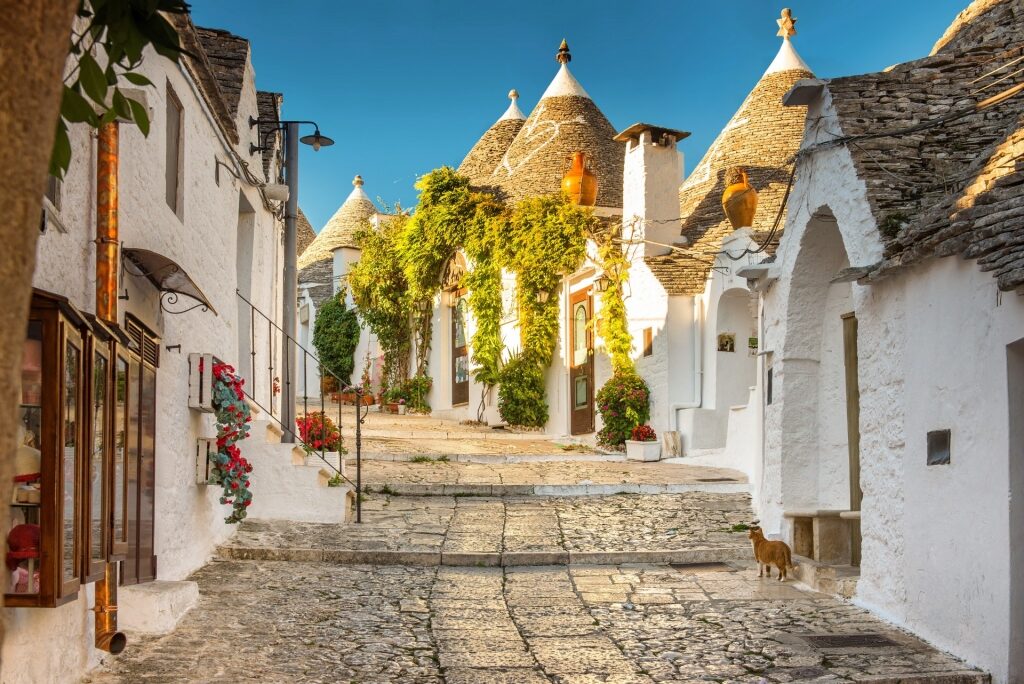
Alberobello
If you decide to make a trip to UNESCO-heritage-listed Alberobello village, just under an hour due north of Taranto. It’s one of the best places to visit in Italy for first-timers to acquaint yourself with Apulia’s rustic larder.
Book on to a half-day tour, and after taking in the famous conical “Trulli” dwellings that are a symbol of this region, you’ll finish with a tasting at a local farm to delve deeper into Italian food culture.
Best Time to Visit Taranto
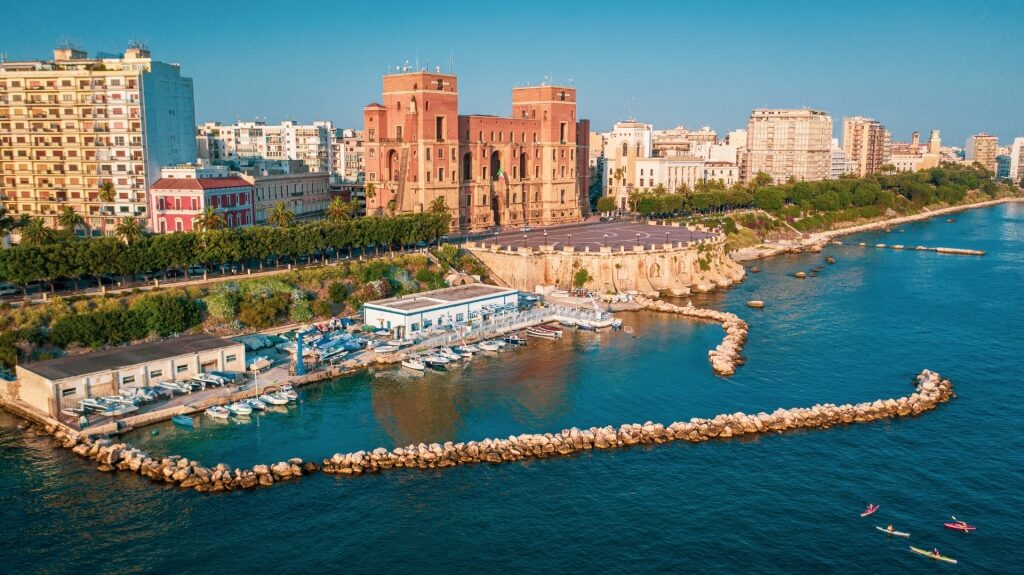
Taranto
The region of Puglia incorporates the protected Gargano Peninsula all the way down to the tip of Italy’s “heel”. Surrounded by the Adriatic Sea and geographically reaching for Greece, this is a land bathed in sunshine (hence the swathes of silvery green olive groves).
In July and August, there’s almost too much sunshine (and sun-seekers) with inland temperatures shooting up to into the 90s (it’s in the high 70s near the coast). But the Italian summertime lingers in Puglia, warming its silver-green shallows and the limestone roofs of its Trulli.
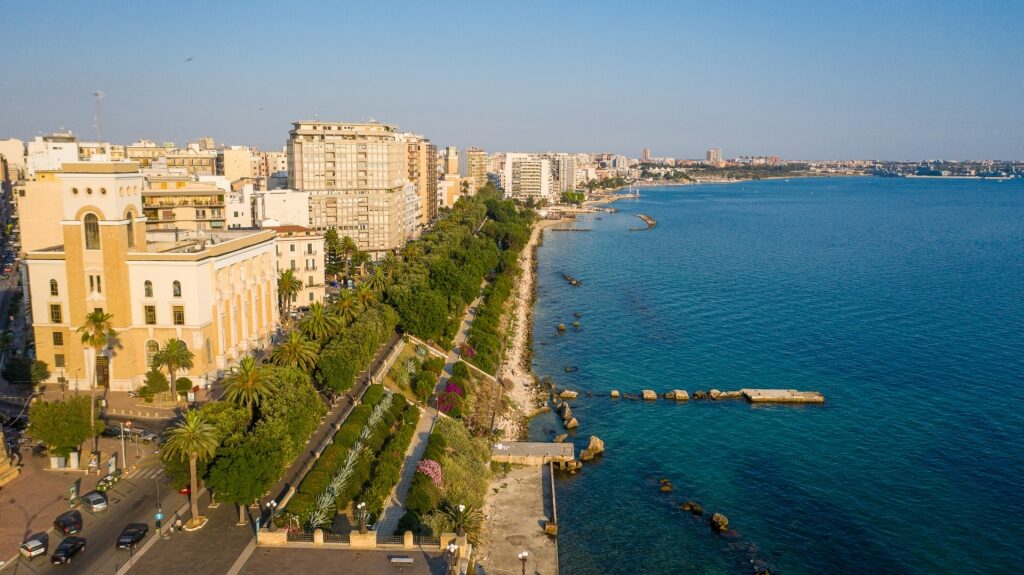
Taranto
Arrive anytime between May and September and you can reliably expect cerulean-skied adventures with balmy 68°F temperatures as a daytime minimum.
In fact, this close to the heart of the Mediterranean, even October can be a travel triumph with deserted beaches and fortune on your side taking the temperatures up to highs of 71°F.
June through to September offers enticing swimming in the Ionian or Adriatic seas with the water reaching a deliciously warm 78°F and staying as high as 76°F.
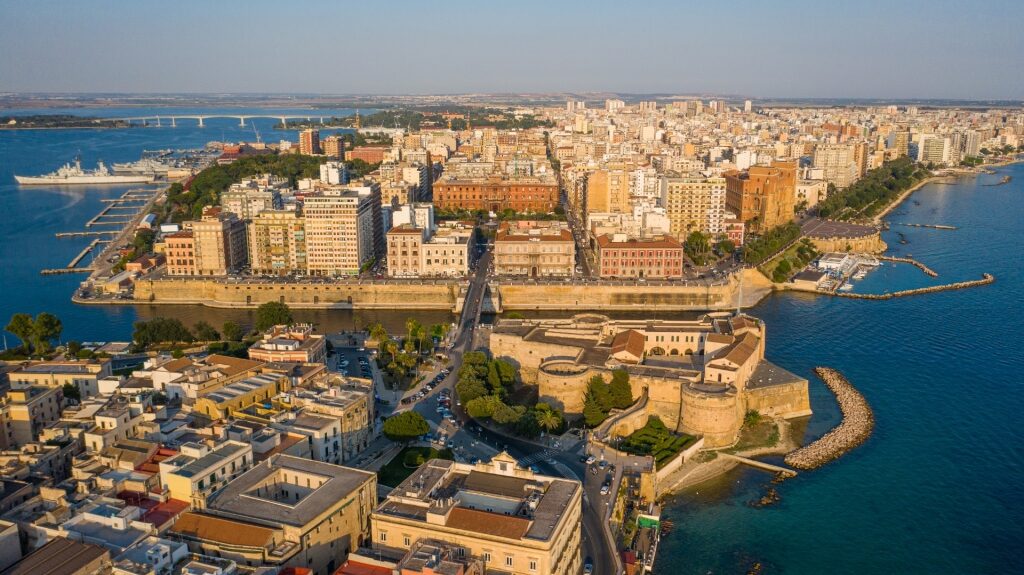
Taranto
Dive into the Ionian’s warm waves and Apulia’s rustic charm on a cruise to Taranto and its two seas. Browse our cruise itineraries online and book an Italian vacation that’ll linger long in the memory.
